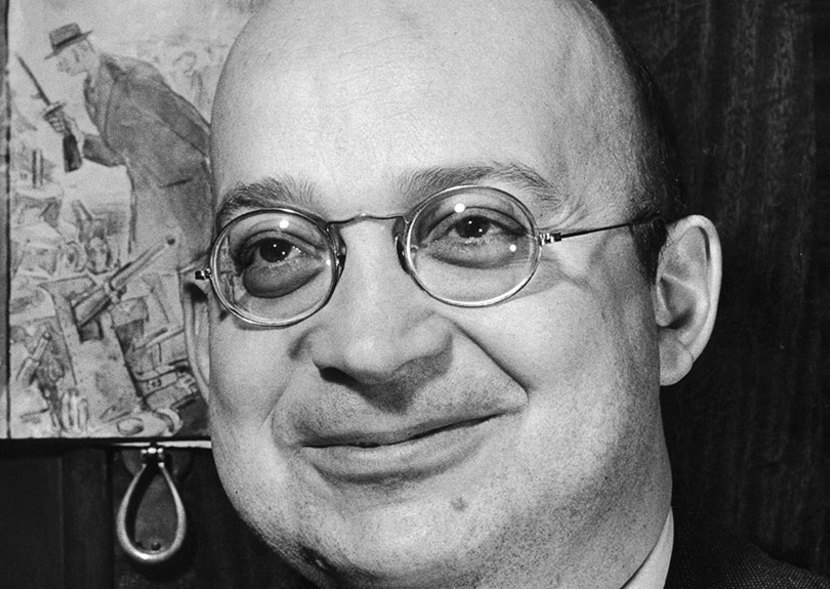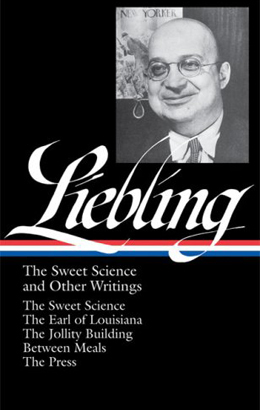In connection with the publication in March 2009 of A. J. Liebling: The Sweet Science and Other Writings, edited by Pete Hamill, Rich Kelley conducted this exclusive interview for the Library of America e-Newsletter.

Library of America: Liebling: The Sweet Science and Other Writings is The Library of America’s second Liebling volume. The first collected his wartime correspondence and his postwar memoir, Normandy Revisited. This new volume collects the five non-war books Liebling wrote after returning from overseas. How is his writing here different from the first volume?
Pete Hamill: In this volume we see Liebling’s writing expand with the confidence, delight, and exuberance of the years after the war. In some ways, the style is more baroque, perhaps idiosyncratic, but that was true to Liebling’s character. He was a gourmand of words, in addition to food. He could be feisty: you see that in “The Wayward Pressman” columns collected in The Press. And he retained his taste for “low” culture too: boxers and corner men, con men and cigar store owners, political hacks and hack drivers. They’re all celebrated in these pages. It was no accident that when Albert Camus came for the first time to New York in 1946, Liebling didn’t guide him through the Metropolitan Museum. He took him to Sammy’s Bowery Follies. Camus was enthralled.
LOA: In January 2003 Sports Illustrated ranked The Sweet Science as #1 of the 100 best sports books ever, hailing Liebling as “pound for pound the top boxing writer of all time Liebling’s writing is efficient yet stylish, acerbic yet soft and sympathetic.” What makes Liebling’s writing on boxing so great?
Hamill: Above all, he had sympathy for the fighters, and those rogues and craftsmen who helped shape them. As a young man, Liebling had taken his own lessons as a boxer. He learned the hard way how difficult an apprenticeship each fighter must serve, how much skill was involved, how much discipline and will. He knew that the toughest prizefighters could be the gentlest of men. He knew that the toughness they exemplified was not the same as meanness, nor still another version of the loudmouth with a pea-sized heart. The prizefighter was a living example of the stoic virtues Liebling saw growing up in New York, then during the Depression, and most of all, among those who fought World War II. He expressed that sympathy without ever lapsing into sentimentality.
LOA: The period The Sweet Science covers, from June 1951 to September 1955, seems to have been a golden age of boxing. Liebling gets to witness the twilight of Joe Louis, the rise of Rocky Marciano, the comeback of Sugar Ray Robinson, the enigma of Archie Moore, and the dramatic ups and downs of the careers of Jersey Joe Walcott and Floyd Patterson. Liebling contends that television’s success in popularizing boxing also killed its local farm system. Do you agree? And is it the dramatis personae who make The Sweet Science so special?
Hamill: Liebling was absolutely right about the collapse of the farm system. I was a young fight fan during that same period and saw fight cards at St. Nicholas Arena, the Eastern Parkway Arena, Sunnyside Gardens, and Fort Hamilton, in addition to the old Madison Square Garden. Within about ten years, most had vanished. Television was just one of the reasons. But also, the times had changed. The hard times of the thirties were good for boxing. The Great Depression toughened people. Fighters developed “heart,” which meant learning how to absorb pain, not just inflict it. After the war everyone felt competitive and it took dozens of bouts for a fighter to get established. The great Sugar Ray Robinson had seventy fights over seven years before he got a title shot. The old pool of talent was changed too. Poor kids who might have become fighters now had other options, many of them flowing from the GI Bill. In the slums, heroin was working its evil ways.
By the 1970s, kids with fifteen professional fights were fighting for championship titles and ending their careers at the age of 22. The level of skill that comes with experience inevitably began to fade. There’s no bench anymore and no way to find out who’s coming along. Almost nobody now can name the heavyweight champion of the world (there seem to be about four of them). The era of The Sweet Science was certainly a glorious and memorable time, but it wasn’t the only golden age. Unfortunately, Liebling only got to cover Ali’s early career and never witnessed the fierce tragedy of Mike Tyson.
LOA: There are so many choice pieces in this collection I have to ask whether you have any favorites?
Hamill: The level of excellence is so high, I really don’t have a single favorite. Often, in need of a shot of vitamins, I take down any Liebling book, open it to a random page and start reading. Now I can do that with just this single volume or its predecessor containing his marvelous reporting on World War II. I cherish the entire Earl Long book, most of Between Meals, and the portrait of Colonel Stingo. Each boxing piece is superb, although I am always knocked over by his account of the Marciano–Moore fight (“Ahab and Nemesis”) and his introduction to The Sweet Science. Even now, with newspapers vanishing everywhere, there is still much to be learned from his press pieces, not simply about the imperfect craft of writing and reporting, but about close reading. Joe Liebling died when he was 59. I wish he had lived to be 80.
LOA: If ever there were a classic New Yorker piece it would have to be the three–part “The Jollity Building” (1941) with its humorous profiles of the Telephone Booth Indians—agents, hustlers and con men who use the nickel phone booths on the ground floor of the Jollity Building as their business phones and who move to upper floors and rise to the status of “heels” and “tenants” as business improves. Do you think the New York Liebling describes ever really existed? Does it still exist anywhere? What happened to it?
Hamill: I want to believe it existed because, as a young reporter in the early 1960s, I knew people who told me they had lived and sort of worked in it. Most of them were press agents and song pluggers who told me the real Jollity Building was the Brill Building, which still exists, now featuring a gleaming lobby. By the time I took a look at it, the Indians were gone. So were the telephone booths, and the laughter. (Other Broadway scholars say that it was a composite of several Depression-era buildings.) Like most of the cultural treasures in Liebling’s book, the old tenants, along with their collective genius for scams, had been evicted by Calvinist agents of the true New York religion, which is real estate. Fortunately, they now continue to live in Liebling’s memorable prose.

LOA: The collection The Jollity Building also includes “Yea Verily,” a long and unforgettable profile of Colonel John R. Stingo (alias James A. Macdonald), a character Liebling’s biographer Raymond Sokolov describes as “the loose-tongued, swivel-minded, Irish, hard-drinking scapegrace, the omnium-gatherum of all the traits that Liebling admired and aspired to as a writer and a man-in-the-city.” Why were characters like Stingo so appealing to Liebling?
Hamill: I’m sure characters like Stingo appealed to Liebling’s deep appreciation of originality, no matter how imperfect. On one level (as a writer), Stingo was an example of what later became known as camp. He was so bad, he was good. But he was also a valuable witness. The reason: Stingo (like Liebling) saw his slice of the world through his own eyes. Like Liebling, he was mercifully free of the prisons of ideology. Like Liebling, he abhorred abstraction. In his writings the Colonel’s use of language was his own; he wasn’t trying to get a job at the Associated Press or establish himself as a successor to Henry James. Liebling, like most New Yorkers, often used irony as a weapon, or a shield. Among many other reasons, he must have loved Stingo as a man who was completely free of irony.
LOA: Many people consider The Earl of Louisiana (1959) to be Liebling’s greatest work. Jonathan Yardley has called it “one of the best books written about American politics.” It concerns Earl Long, Huey Long’s younger brother who after winning the governorship for the third time in 1956, had to run his administration for a time from the confines of a mental institution. Liebling travels to Louisiana in 1959 and 1960 to chronicle Long’s attempt to run for a fourth term. What makes this such a classic work of political journalism?
Hamill: The Earl of Louisiana is a perfect example of what every fine reporter knows: Don’t think you know what the story is before you leave the office. He knew the rough outlines of the story, of course, the coloring book version. And as a big-city liberal, he must have felt deeply the racial context, boiling under the challenge of the Civil Rights movement. But he didn’t go to Louisiana to seek out editorial cartoons. He found that the players were all more complicated than most observers said they were, even the dunderheads. And hilarious too. The book tells us much about the process of politics, but it is also about race, and change, in a country that now has an African-American president.
LOA: The appendix to this volume includes the previously uncollected “Anti-Poetry Night,” Liebling’s fourteen-page profile of the March 1963 heavyweight fight between Cassius Clay (later Muhammad Ali) and Doug Jones at Madison Square Garden. Liebling died later that year and so wasn’t around to see Ali develop as a fighter. Do you think he had a sense of what lay ahead for Ali?
Hamill: Liebling would have loved Ali in his prime. He’d have recognized that what seemed like brash arrogance was usually expressed with a wink. He’d have appreciated Ali’s growing skill, his ability to get up when knocked down, his strategic mastery in the ring. And I’m sure he would have defended Ali during those three shameful years when Ali was suspended for refusing to go into the Army during the Vietnam War. Here, he certainly would have turned to the great Arab historian, Ibn Khaldun, to find cultural and theological explanations for Ali’s refusal. Ironically, of course.
LOA: A good third of the thousand pages in this volume is devoted to The Press, a collection of the eighty pieces of press criticism Liebling wrote for The New Yorker between 1945 and 1963. In an article in Slate in 2004 Jack Shafer notes that forty years after his death “Liebling continues to reign as the great American press critic” and he laments that no one has risen to take his place. “Every sentence he wrote contains a kick, a bounce, and a leap,” Shafer writes. Given all the turmoil in the newspaper business these days, are there things the current generation of reporters and newspaper owners can learn from Liebling?
Hamill: The Press has a lot of valuable things to say to today’s journalists for one very good reason: it’s as much about the craft as it about the politics of investigating the news. Many critics of the press never worked at a newspaper. They don’t know how it’s done, under the pressures of time and space. What’s appealing about Liebling is that he wasn’t an ideologue. He was a liberal, for sure. But his personal vision of America (formed in atypical New York) never interferes with what he’s trying to do. He’s writing about how reporters and editors do their jobs as much as he’s dealing with the substance of what they’re writing about. Take a piece like “The Rubber-Type Army” (1951). Liebling is hilarious speculating on how various reporters arrived at their estimates of the size of Chiang Kai-shek’s army, from 450,000 to 1,000,000, and of the number of guerrillas, which he found could range from 1,000,000 to 6,000,000. While exposing the sloppiness and untrustworthiness of the reports, his commentary also demonstrates why a thinking reporter would never make these mistakes. He’d have had a field day with the reporting before the war in Iraq. That’s his value these many years later: he’s not just teaching us how to report, he’s teaching us how to read, and how to read closely.
LOA: The last book Liebling published during his lifetime was Between Meals: An Appetite for Paris, and it is not just a collection of reminiscences about fabulous gustatory adventures in Paris—it also seems to be an apologia for a way of life. Even while Liebling’s 243-pound frame and indulgent eating were ruining his health, he was writing that his gourmand mentor, Yves Mirande, died because the healthy diet his doctor prescribed had rotted his insides. “What he called his pipes (ma tuyauterie’), being insufficiently exercised, lost their tone, like the leg muscles of a retired champion.” Is Liebling serious here?
Hamill: He is being very serious, again using irony to distance himself from the ominous personal possibilities. He was notorious for his eating—and the effects showed. I met Joe Liebling in September 1962 at the Chicago press headquarters for the first Patterson-Liston fight. I had been warned by a friend to avoid shaking his hand. “He’s got the gout,” my friend said. “Both hands.” Liebling said to me, in a soft whispery voice, something nice about some stories I had written the previous spring for The New York Post about the death of a fighter named Benny (Kid) Paret. His words were like being awarded a prize. I reached to shake his hand, remembered, and squeezed his forearm instead. He winced anyway. And then smiled.
LOA: Liebling published some fifteen books during his life and frequently complained to his publishers that none of them sold very well. In the eulogy he delivered at Liebling’s funeral Joseph Mitchell recalled what a Fourth Avenue secondhand bookseller told him: “The moment one of his books turns up, it goes out immediately to someone on my waiting list . . . Literary critics don’t know which books will last, and literary historians don’t know. . . . We are the ones who know. We know which books can be read only once, if that, and we know the ones that can be reread and reread and reread.” How do you explain this disconnect between Liebling’s lack of popularity during his lifetime and his growing stature now?
Hamill: There’s no explaining that disconnect. I suspect that Liebling drew some consolation by remembering that one of his literary heroes, Stendhal (Henri–Marie Beyle), once said that he wrote for “the Happy Few.” Stendhal was, of course, a master of irony. He died in 1842 at 59, the same age Joe Liebling was when he died in 1963. Stendhal wasn’t fully appreciated until the early twentieth century. And here we are, more than forty years after Joe Liebling wrote his last reported essay, and his work still lives. This volume is the proof.




